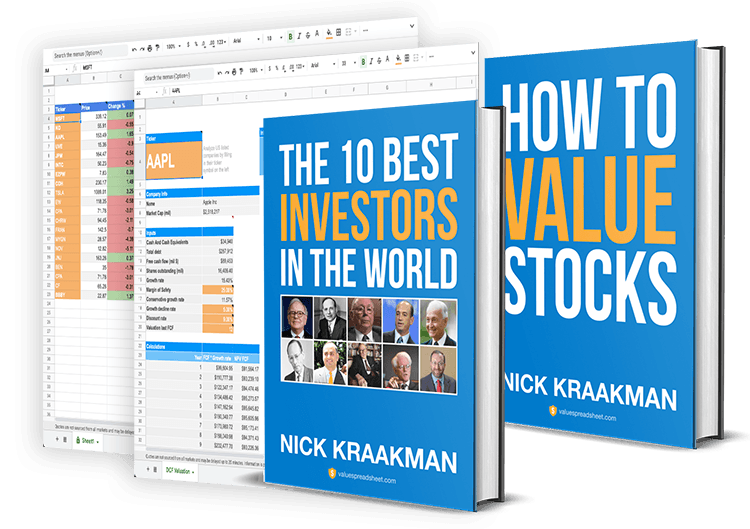Transcript
Hello, and thanks again for tuning in to the Value Investing Bootcamp podcast.
I'm your host, Nick Kraakman, and I'm really amazed at the amount of questions I have received from you guys since the last episode in which we discussed how to value a company, how to calculate the intrinsic value of a company.
I received many questions and I answered all of them, so I hope you are content with the answers I've been giving you.
Otherwise, just shoot me another email!
And if you haven't sent me an email yet, or a tweet, you can also send me a tweet @ValueSheet, or an email to
So, thanks again for all the support and all the positive comments that I've received from you guys.
I really, really appreciate it. You're all awesome. It really motivates me to continue this, and to give it my best.
So, what we're going to do today is talk about three different rates, which are all important to investors.
We're talking about interest rates, growth rates and discount rates.
So, what is the difference?
Well, an interest rate is the amount of money you have to pay, the percentage you have to pay when you take on a loan.
That is called the interest rate.
The growth rate is, for example, the growth rate of what we are talking about is the earnings growth rate, so what percentage earnings grow of a company on an annual basis or quarterly basis.
And then the discount rate, which is a fictitious rate which we use to calculate the value of $1 in the future in today's money.
We talked about this in the previous episode, it's called the net present value, and it's used in a lot of valuation models.
So, that's the discount rate.
Let's start with the interest rate.
At this moment, interest rates are at a historically low point, they're almost-- well, they're below 1%, and this means that companies can loan money at very cheap rates, which means if it's easy to get money, if it's cheap to get more money using a loan, this creates more money, this makes more money available, also to invest in stocks.
So, what you often see is when interest rates are low, stock prices generally go up.
While stock prices have been going up for the past couple of months, this low interest rate has been partially causing that.
It's sort of an artificial, yeah, boom, which we have seen in the last couple of months or even years, that this interest rate has been so low.
Expect that once they start increasing the interest rate again, we will get a downward pressure on stock prices, so keep that in mind.
Then another rate that is important to investors is the earnings growth rate.
There is the historical growth rate, of course, you can just see, okay, in one year company made $100 million profit, in the next year, it made $110 million profit, so the earnings growth rate is 10%.
That's all good, however, investors are mostly interested in future growth rates, and the problem with the future is that it's hard to predict or even sometimes impossible to predict.
However, we can make an educated guess.
We can base our future, our expected growth rate, on the historical growth rate.
So, as I just said, you can look at how fast a company's earnings have been growing in the past, and then base your growth rates on that, or you can look at what analysts are predicting.
You can go to finance.yahoo.com and see what analysts are predicting for the coming five years.
However, this is not to say that this-- I mean, these guys, these analysts, they're often spending a lot of time researching stocks, so their estimates are based on a lot of research, but this does not mean that they can predict the future better than someone else can.
I mean, it's still a matter of predicting based on assumptions, and it's not always easy to do this.
So, just take them with a grain of salt, and always try to be a bit conservative with your growth rates, because a growth rate can have a major impact on the valuation that you-- the intrinsic value that you calculate for a company.
If you base your decisions on that, be sure to, yeah, make a conservative estimate, and one way I do this, personally, is by taking this analyst estimate, and then multiplying it by 0.75.
What this does is it just applies a 25% safety margin; it lowers the predicted growth rate by 25%, which means you end up with a more conservative estimate, and this is easier for a company to meet and to exceed.
So, if you use this conservative growth rate, and you still find that a company is attractive to buy, even if it would grow at that conservative rate, then yeah, you set yourself up for success, because you minimize the downside risk while maximizing the upside potential, the upside surprise you know.
Because if it does perform as well as the analysts expect, then yeah, you were using your conservative rate, so you've probably bought it at such a low price that you will make a lot of money when the company does perform as well as the analysts expected.
The final rate is the discount rate.
As I said, this is the fictitious, imaginary rate that you use to calculate the net present value of future $1.
So, we explained that $1 today is worth more than $1 in the future, this is what we talked about in a previous episode, because this dollar if you have it today, you can invest it and you can earn a return on it, so it will grow over time, so it will be worth more than $1 in the future.
But the discount rate that you use is therefore related to how much money you can reasonably earn with this $1 today.
So, if you want to calculate the net present value of a stock, which is often used in stock valuation models, the discount rate that I prefer to use is the average return of the stock market, the average historical return of the stock market, which has been between 8 and 10%.
Using any of these-- for example, if you use 10%, you will get a more conservative estimate.
If you use 8%, you get a slightly less conservative estimate.
So, I usually aim for 9 or 10% as a discount rate, and this will give you a conservative estimate of the intrinsic value.
If you also use a conservative growth rate, then you can be sure that your estimate is also conservative, and if you then buy way below the value that you calculate, you build in a big margin of safety and room for error, because you are, of course, acting on imperfect information.
This will allow you to minimize risk while maximizing the upside potential.
So, don't really rely on what estimates the analysts make, just take them with a grain of salt, especially when these estimates are extremely high.
You should never rely on high expected growth, because this is just very hard to meet.
For example, if you look at Tesla Motors at this moment, the stock price is so high, it would require such high growth rates to justify this stock price, it's just unreasonable.
And also, keep in mind that the current stock prices have risen significantly, because they experienced an upward pressure because of the low interest rates, but this is an artificial pressure, and once these interest rates are inevitably-- they will be increased in the near future, and this will create a significant downward pressure on stock prices.
So, keep that in mind and I'll see in the next episode, where we will talk about when to buy and when to sell.
Thank you very much and have a great day!
If you enjoyed today's show, head over to ValueInvestingBootcamp.com to find out more on how you can invest like the pros, manage your own portfolio with confidence, and consistently earn mind boggling returns on the stock market.



